Numeta G13%E Emulsion For Infusion
Package leaflet: Information for the user NUMETA G13%E emulsion for infusion
Read all of this leaflet carefully before you start using this medicine because it contains important information for you.
- Keep this leaflet. You may need to read it again.
- If you have any further questions, ask your child’s doctor, pharmacist or nurse.
- If your child gets any side effects, talk to your child’s doctor or nurse. This includes any possible side effects not listed in this leaflet. See section 4.
The medicine is called NUMETA G13%E emulsion for infusion but will be referred to as NUMETA through the remainder of this leaflet.
What is in this leaflet:
1. What NUMETA is and what it is used for
2. What you need to know before your child is given NUMETA
3. How NUMETA is given
4. Possible side effects
5. How to store NUMETA
6. Contents of the pack and other information
1. What NUMETA is and what it is used for
NUMETA G13%E is a specialised nutrition emulsion designed for for preterm newborns. It is given through a tube which is placed in your child’s vein, when your child is not able to eat all of his or her nutrition by mouth.
NUMETA is presented in the form of a three chamber bag in which the separate chambers contain:
a 50 % glucose solution
a 5.9% paediatric amino acid solution, with electrolytes a 12.5% lipid (fat) emulsion
Depending on your child’s needs, two or three of these solutions are mixed together in the bag before it is given to your child.
NUMETA must only be used under medical supervision.
2. What you need to know before your child is given NUMETA Your child should not be given NUMETA, in the following cases:
With 2 solutions mixed together in the bag (“2 in 1”):
- If your child is allergic to egg proteins, soya, peanuts or to any ingredient in the glucose or amino acids chamber (listed in section 6).
- If your child’s body has problems using building blocks of protein.
- If your child has high concentrations of any of the electrolytes included in NUMETA in their blood.
- If your child is newborn (<28 days of age), NUMETA (or other calcium containing solutions) must not be given at the same time as ceftriaxone (an antibiotic), even if separate infusion lines are used. There is a risk of particle formation in the newborn's bloodstream which may be fatal.
- If your child has hyperglycaemia (especially high levels of sugar in their blood).
With 3 solutions mixed together in the bag (“3 in 1”).
- All of the above situations mentioned for the “2 in 1” plus the following:
- If your child has especially high level of fats in their blood.
In all cases, your doctor will base their decision on whether your child should receive this medicine on factors such as age, weight and clinical condition. Your doctor will also consider the results of any tests performed.
Warnings and precautions
Talk to your child’s doctor or nurse before they are given NUMETA.
Allergic Reactions:
The infusion must be stopped immediately if any signs or symptoms of an allergic reaction (such as fever, sweating, shivering, headache, skin rashes, or difficulty breathing) develop. This medicinal product contains soybean oil, which may rarely cause hypersensitivity reactions. Uncommonly, it has been observed that some people who are allergic to peanut proteins are also allergic to soybean proteins.
Infection and Sepsis:
Your doctor will carefully watch your child for any signs of infection. An “aseptic technique” (germ free technique) when placing and maintaining the catheter as well as when making the nutritional formula can reduce the risk of infection.
Occasionally, children can develop infection and sepsis (bacteria in the blood) when they have a tube in their vein (intravenous catheter). Certain medications and illnesses can increase the risk of developing infection or sepsis. Patients who require parenteral nutrition (giving nutrition through a tube in your child’s vein) can be more likely to develop infection from their medical conditions.
Fat overload syndrome:
Fat overload syndrome has been reported with similar products. The reduced or limited ability of the body to remove the fats contained in NUMETA may result in a "fat overload syndrome" (see section 4 - Possible Side Effects).
Changes in blood chemistry levels:
Your doctor will check and monitor your child’s fluids, blood chemistries and other blood levels since occasionally, refeeding someone who is severely undernourished can result in changes in blood chemistry levels. Extra fluid in the tissues and swelling can also develop. It is recommended that parenteral nutrition is started slowly and carefully.
Monitoring and Adjustment:
Your doctor will be closely monitoring and adjusting NUMETA to meet your child’s individual needs if they have the following conditions:
- severe post-traumatic conditions
- severe diabetes mellitus
- shock
- heart attack
- severe infection
- certain types of coma
Use with caution:
NUMETA should be used with caution if your child has:
- pulmonary oedema (fluid in the lungs) or heart failure.
- severe liver problems.
- problems in using nutrients.
- high blood sugar.
- kidney problems.
- severe metabolic disorders (when the body cannot break down substances in a normal way).
- blood clotting disorders.
Your child's fluid status, liver test values and/or blood values will be closely monitored.
There is limited information on giving this medicine in preterm (premature) infants less than 28 weeks gestational age.
Other medicines and NUMETA
Tell your doctor if your child is taking or using, has recently taken or used or might take or use any other medicines.
NUMETA must not be given at the same time as:
• blood through the same infusion tubing due to the risk of pseudoagglutination (red blood cells becoming stuck together in a stack).
• Ceftriaxone (an antibiotic) because of the risk of particle formation.
Coumarin and warfarin (Anticoagulants):
Your doctor will carefully watch your child if they are taking coumarin or warfarin. Olive and soybean oil have a natural content of vitamin K1. Vitamin K1 may interfere with drugs such as coumarin and warfarin. These drugs are anticoagulants used to prevent clotting of the blood.
Laboratory tests:
The fats contained in this emulsion may interfere with the results of certain laboratory tests. Laboratory tests may be performed after a period of 5 to 6 hours when no additional lipids are administered.
Interactions of NUMETA on drugs that may affect potassium levels/metabolism:
NUMETA contains potassium. High levels of blood potassium may cause abnormal heart rhythm. Special care should be taken in patients taking diuretics (drugs to reduce fluid retention) or ACE inhibitors (drugs for high blood pressure) or angiotensin II receptor antagonists (drugs for high blood pressure) or immunosuppressants (drugs that may lower the body’s normal immune defences). These types of drugs may increase potassium levels.
Pregnancy, breast-feeding and fertility
There are no adequate data from the use of NUMETA in pregnant or breast feeding women. Your doctor will carefully consider the potential risks and benefits for each patient before prescribing NUMETA.
3.
How NUMETA is given
Your child should always be given NUMETA exactly as the doctor has indicated. Check with your doctor if you are not sure.
Age group
NUMETA G13%E has been designed to meet the nutritional needs of preterm newborns.
NUMETA may not be appropriate for some preterm infants, as their condition may require individualised formulations to meet their specific nutritional needs. Your doctor will decide if this medicine is suitable for your child.
Administration
This medicine is an emulsion for infusion. It is given through a plastic tube in a vein in your child’s arm or in a large vein in your child’s chest.
Your child’s doctor may choose not to give fats to your child. The design of the NUMETA bag allows only the peel seal between the amino acids/electrolyte and glucose chambers to be broken if necessary. The peel seal between the amino acids and fat chambers remains intact in this case. The content of the bag can then be infused without fats.
Dosage and duration of treatment
Your child’s doctor will decide the dose and for how long it will be given. The dosage depends on the nutrition needs of your child. The dosage will be based on your child’s weight, medical condition, and on their body’s ability to break down and use the ingredients in NUMETA. Additional nutrition or proteins given orally/enterally may also be given.
If your child is given too much NUMETA
Symptoms
Too much of this medicine, or giving it too quickly:
- nausea (feeling sick)
- vomiting
- shivering
- electrolyte disturbances (improper amounts of electrolytes in the blood)
- signs of hypervolemia (increase of circulating blood volume)
- acidosis (increased acidity of the blood)
In such situations, the infusion must be stopped immediately. Your child’s doctor will decide if additional actions are required.
To prevent these events occurring, the doctor will regularly monitor your child’s condition and test their blood levels during treatment.
4. Possible side effects
Like all medicines, this medicine can cause side effects, although not every child gets them.
If you notice any changes in the way your child feels during or after the treatment, tell your doctor or nurse straight away.
The tests your doctor will perform while your child is taking the medicine should minimise the risk of side effects.
If signs of an allergic reaction occur, the infusion shall be stopped and a doctor contacted immediately. This can be serious and the signs may include:
- sweating
- shivering
- headache
- skin rashes
- breathing difficulties
Other side effects that have been noticed are:
Common: may affect up to 1 in 10 people
- Low phosphate level in the blood (hypophosphataemia)
- High sugar level in the blood (hyperglycaemia)
- High calcium level in the blood (hypercalcaemia)
- High triglycerides level in the blood (hypertriglyceridaemia)
- Electrolyte disturbance (hyponatraemia)
Uncommon: may affect up to 1 in 100people
- High fat level in the blood (hyperlipidaemia)
- Condition where bile cannot flow from the liver to the duodenum, a part of the intestines (cholestasis).
The reduced or limited ability to remove the fats contained in NUMETA may result in a "fat overload syndrome”. The following signs and symptoms of this syndrome are usually reversible when the infusion of the fat emulsion is stopped:
- Sudden and abrupt worsening of the patient’s medical condition
- High levels of fats in the blood (hyperlipidaemia)
- Fever
- Liver enlargement and fatty infiltration (hepatomegaly)
- Worsening liver function
- Reduction in red blood cells which can make the skin pale and cause weakness or breathlessness (anaemia)
- Low white blood cell count, which can increase the risk of infection (leukopenia)
- Low platelet count which can increase the risk of bruising and/or bleeding (thrombocytopenia)
- Coagulation disorders which effect the ability of the blood to clot
- Coma, requiring hospitalisation.
Reporting of side effects
If your child gets any side effects talk to your child’s doctor or nurse. This includes any possible side effects not listed in this leaflet.
You can also report side effects directly (see details below). By reporting side effects you can help provide more information on the safety of this medicine.
United Kingdom:
Via the Yellow Card Scheme at: www.mhra.gov.uk/yellowcard
Republic of Ireland:
FREEPOST,
Pharmacovigilance Section,
Irish Medicines Board,
Kevin O’Malley House,
Earlsfort Centre,
Earlsfort Terrace,
Dublin 2,
Ireland.
Tel: +353 1 6764971,
Fax: +353 1 6762517,
Website: www.imb.ie e -mail: imbpharmacovigilance @imb.ie
5. How to store NUMETA
Keep this medicine out of the sight and reach of children when not being administered.
Do not use this medicine after the expiry date which is stated on the bag and the outer packaging (MM/YYYY). The expiry date refers to the last day of that month.
Do not freeze.
Store in the overpouch.
Do not throw away any medicines via wastewater or household waste. Ask your pharmacist how to throw away medicines you no longer use. These measures will help protect the environment.
6. Contents of the pack and other information What NUMETA looks like and contents of the pack
NUMETA is presented in the form of a triple-chamber bag. Each bag contains a sterile combination of a glucose solution, an amino acid solution for children, with electrolytes, and a lipid emulsion, as described below.
|
Container size |
50% glucose solution |
5.9% amino acids solution with electrolytes |
12.5% lipid emulsion |
|
300 ml |
80 ml |
160 ml |
60 ml |
The active substances for each bag of the reconstituted emulsion are:
|
Ingredient (per bag) |
300 ml | |
|
Per 2-in-1 or 3-in-1 admixture |
2-in-1 240 ml |
3-in-1 300 ml |
|
Active substance | ||
|
Alanine |
0.75 g |
0.75 g |
|
Arginine |
0.78 g |
0.78 g |
|
Aspartic acid |
0.56 g |
0.56 g |
|
Cysteine |
0.18 g |
0.18 g |
|
Glutamic acid |
0.93 g |
0.93 g |
|
Glycine |
0.37 g |
0.37 g |
|
Histidine |
0.35 g |
0.35 g |
|
Isoleucine |
0.62 g |
0.62 g |
|
Leucine |
0.93 g |
0.93 g |
|
Lysine monohydrate |
1.15 g |
1.15 g |
|
equivalent to Lysine |
1.03 g |
1.03 g |
|
Methionine |
0.22 g |
0.22 g |
|
Ornithine hydrochloride |
0.30 g |
0.30 g |
|
equivalent to Ornithine |
0.23 g |
0.23 g |
|
Phenylalanine |
0.39 g |
0.39 g |
|
Proline |
0.28 g |
0.28 g |
|
Serine |
0.37 g |
0.37 g |
|
Taurine |
0.06 g |
0.06 g |
|
Threonine |
0.35 g |
0.35 g |
|
Tryptophan |
0.19 g |
0.19 g |
|
Tyrosine |
0.07 g |
0.07 g |
|
Valine |
0.71 g |
0.71 g |
|
Potassium acetate |
0.61 g |
0.61 g |
|
Calcium chloride dihydrate |
0.55 g |
0.55 g |
|
Magnesium acetate tetrahydrate |
0.27 g |
0.27 g |
|
Sodium glycerophosphate, hydrated |
0.98 g |
0.98 g |
|
Glucose monohydrate |
44.00 g |
44.00 g |
|
equivalent to Glucose anhydrous |
40.00 g |
40.00 g |
|
Olive oil, refined + Soya bean oil, refined |
- |
7.5 g |
The other ingredients are purified egg phosphatide, glycerol, sodium oleate, l-malic acid, hydrochloric acid, sodium hydroxide, water for injections.
Appearance before reconstitution:
• The solutions in the amino acids and glucose chambers are clear, colorless or slightly yellow
• The fat emulsion chamber is a uniform and milky-white liquid Appearance after reconstitution:
• “2 in 1” solution for infusion is clear, colorless or slightly yellow
• “3 in 1” emulsion for infusion is uniform and milky-white
The three-compartment bag is a multi-layer plastic bag.
To prevent air contact, NUMETA is packaged in an oxygen barrier overpouch that may also contain an oxygen absorber.
Pack sizes 300 ml bag: 10 units per cardboard box 1 bag of 300 ml
Not all pack sizes may be marketed.
Marketing Authorisation Holder and Manufacturer
Marketing Authorisation Holder
Baxter Healthcare Limited Caxton Way, Thetford,
Norfolk, IP24 3SE,
UNITED KINGDOM
Manufacturer
BAXTER S.A.
BOULEVARD RENE BRANQUART, 80
7860 LESSINES
BELGIUM
This leaflet was last revised in 11/2013
For information about NUMETA or to request this leaflet in formats such as audio or large print please contact the Marketing Authorisation Holder:
Tel: +44 (0)1635 206345.
The following information is intended for medical or healthcare professionals only1
*Please observe that in certain cases this product may be administered at home by parents or other caregivers. In such cases parents/caregivers should read the following information.
No additions to the bag should be made without first checking the compatibility. Formation of particles or breaking down of the lipid emulsion could result. This can lead to blockage of the blood vessels.
NUMETA should be at room temperature before use.
Before taking NUMETA, the bag will be prepared as shown below.
Confirm that the bag is not damaged. Use the bag only if it is not damaged. An undamaged bag looks like this:
Before opening the overpouch, check the colour of the oxygen absorber if present. The oxygen absorber is a coloured disc that may be included in the overpouch. Check the reference colour printed next to the OK symbol in the printed area of the indicator label. Do not use the bag if the colour of the oxygen absorber does not match the reference colour printed next to the OK symbol.

To open: Remove the protective overpouch. Discard the overpouch and oxygen absorber, if present.

Mixing: The product should be at room temperature when the non-permanent seals are broken. Place the bag onto a flat clean surface. Do not use the bag if the contents have been mixed due to unintended breaking of compartment seals during transport.
Activating the 3 chamber bag (mixing of 3 solutions)
Roll the bag from the top (hanger end) corner of the lipid emulsion compartment.
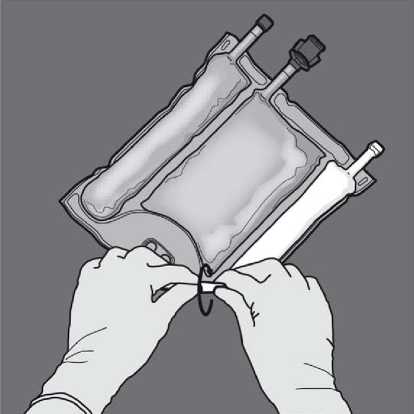
Apply pressure to open the first seal.

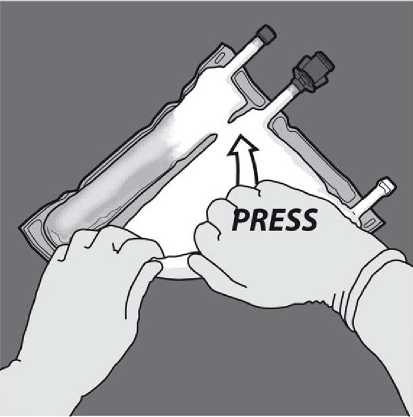
Open all seals completely. Continuing to apply pressure with one hand and rolling the bag towards the tubes.

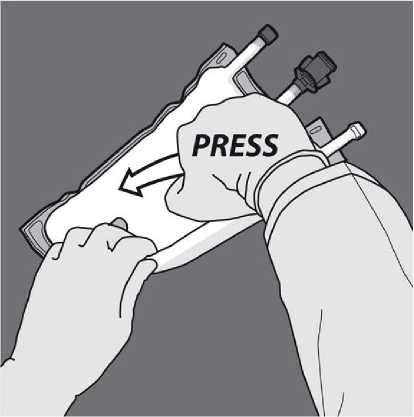
Turn the bag over at least three times to mix the contents thoroughly. The appearance of the mixed solution should be a milky-white emulsion.
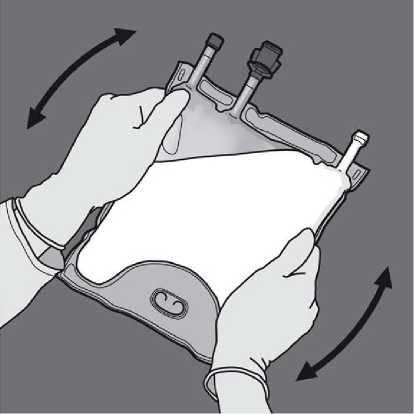
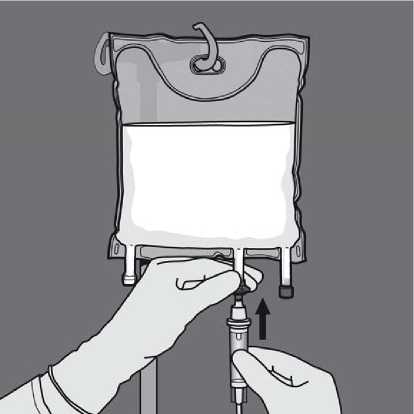
Activating the 2 chambers (mixing 2 solutions)
To mix only 2 solutions, roll the bag from the top (hanger end) corner of the seal separating the solutions. Apply pressure to open the seal separating the glucose and amino acids compartments.
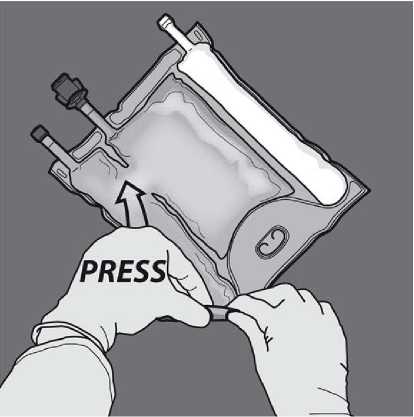
Orient the bag such that the lipid emulsion compartment is nearest to the operator. Roll the bag while protecting the lipid emulsion compartment in the palms of the hands.
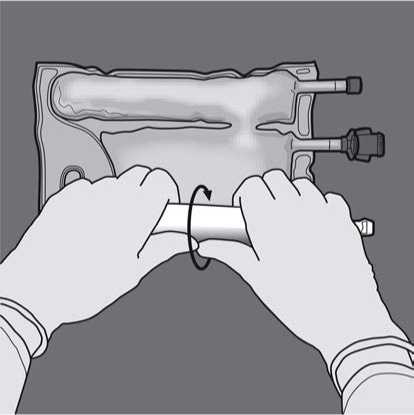
Apply pressure with one hand and roll the bag toward the tubes.
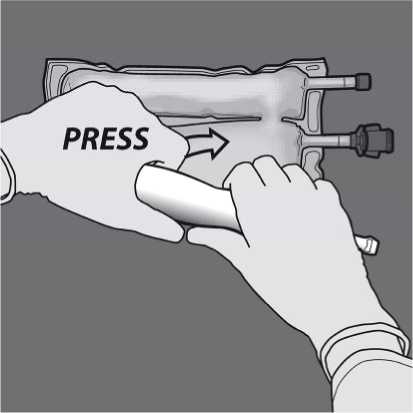
Change direction by rolling the bag towards the top (hanger end). Press with the other hand, continuing until the seal separating the amino acids and glucose solutions is completely opened.
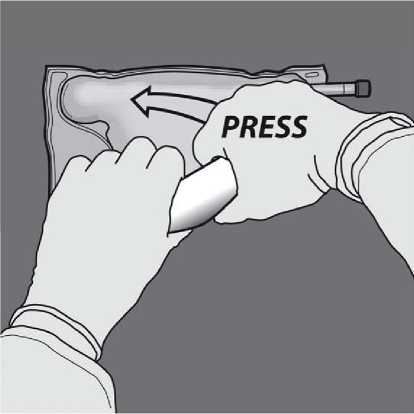
Turn the bag over at least three times to mix the content thoroughly. The appearance of the mixed solution should be clear, colorless or slightly yellow.
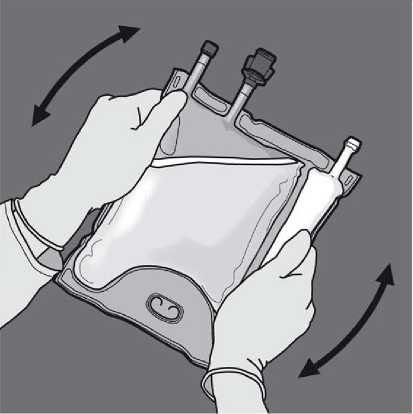
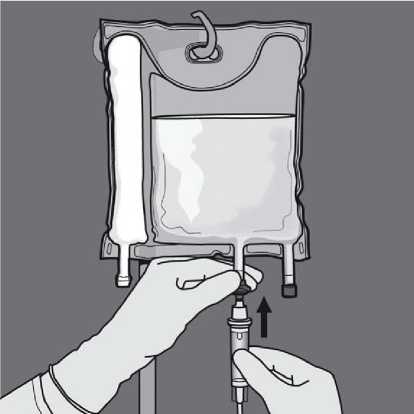
The flow rate should be increased gradually during the first hour. The administration flow rate must be adjusted based on the following factors: the dose being administered the daily volume intake the duration of the infusion.
Shelf Life after the Solutions are Mixed
Use the product immediately after the non-permanent seals between the two or three chambers have been opened. Stability studies of the mixtures have been performed for 7 days between 2°C and 8°C followed by 48 hours at 30°C.
Shelf life after supplementation
After addition of electrolytes, trace elements and vitamins to the 2 and 3 chamber mixtures, with and without dilution, in-use stability data supports 7 days, between 2°C and 8°C followed by 48 hours at 30°C.
From a microbiological point of view, the product should be used immediately. If not used immediately, in-use storage times and conditions prior to use are the responsibility of the user and would normally not be longer than 24 hours at 2 to 8°C, unless reconstitution /dilution /supplementation has taken place in controlled and validated aseptic conditions
Do not use NUMETA if the bag is damaged. A damaged bag looks like this:
• The non-permanent seals are broken
• Any one of the chambers contains a mixture of any of the solutions
• The amino acids solution and the glucose solution are not clear, colorless, or slightly yellow, and/or contain visible particles
• The lipid emulsion is not a uniform liquid with a milky white appearance.
Medicines should not be disposed of via wastewater or household waste. Ask your pharmacist how to dispose of medicines no longer required. These measures will help to protect the environment.
|
Ingredient (per bag) |
300 ml | |
|
Per 2-in-1 or 3-in-1 admixture |
2-in-1 240 ml |
3-in-1 300 ml |
|
Active substance | ||
|
Alanine |
0.75 g |
0.75 g |
|
Arginine |
0.78 g |
0.78 g |
|
Aspartic acid |
0.56 g |
0.56 g |
|
Cysteine |
0.18 g |
0.18 g |
|
Glutamic acid |
0.93 g |
0.93 g |
|
Glycine |
0.37 g |
0.37 g |
|
Histidine |
0.35 g |
0.35 g |
|
Isoleucine |
0.62 g |
0.62 g |
|
Leucine |
0.93 g |
0.93 g |
|
Lysine monohydrate |
1.15 g |
1.15 g |
|
equivalent to Lysine |
1.03 g |
1.03 g |
|
Methionine |
0.22 g |
0.22 g |
|
Ornithine hydrochloride |
0.30 g |
0.30 g |
|
equivalent to Ornithine |
0.23 g |
0.23 g |
|
Phenylalanine |
0.39 g |
0.39 g |
|
Proline |
0.28 g |
0.28 g |
|
Serine |
0.37 g |
0.37 g |
|
Taurine |
0.06 g |
0.06 g |
|
Threonine |
0.35 g |
0.35 g |
|
Tryptophan |
0.19 g |
0.19 g |
|
Tyrosine |
0.07 g |
0.07 g |
|
Valine |
0.71 g |
0.71 g |
|
Potassium acetate |
0.61 g |
0.61 g |
|
Calcium chloride dihydrate |
0.55 g |
0.55 g |
|
Magnesium acetate tetrahydrate |
0.27 g |
0.27 g |
|
Sodium glycerophosphate, hydrated |
0.98 g |
0.98 g |
|
Glucose monohydrate |
44.00 g |
44.00 g |
|
equivalent to Glucose anhydrous |
40.00 g |
40.00 g |
|
Olive oil, refined + Soya-bean oil, refined |
- |
7.5 g |
|
Characteristic (per 100 ml) |
300 ml | |
|
Per 2-in-1 or 3-in-1 admixture |
2-in-1 |
3-in-1 |
|
Volume (ml) |
240 |
300 |
|
Nitrogen (g) |
0.59 |
0.47 |
|
Amino acids (g) |
3.9 |
3.1 |
|
Glucose (g) |
16.7 |
13.3 |
|
Lipids (g) |
n.a. |
2.5 |
|
Energy: | ||
|
Total calories (kcal) |
83 |
91 |
|
Non-protein calories (kcal) |
67 |
78 |
|
Glucose calories (kcal) |
67 |
53 |
|
Lipid calories (kcal) |
n.a. |
25 |
|
Electrolytes: | ||
|
Sodium (mmol) |
2.7 |
2.2 |
|
Potassium (mmol) |
2.6 |
2.1 |
|
Magnesium (mmol) |
0.52 |
0.42 |
|
Calcium (mmol) |
1.57 |
1.25 |
|
Phosphate * (mmol) |
1.34 |
1.26 |
|
Acetate (mmol) |
3.7 |
2.9 |
|
Chloride (mmol) |
3.9 |
3.1 |
|
Malate (mmol) |
1.3 |
1.1 |
|
pH |
5.5 |
5.5 |
|
Osmolarity (mOsm/l) |
1410 |
1155 |
Phosphate for 3-in-1 admixtures includes phosphorus from lipid emulsion (egg phospholipids) n.a.: not applicable
L-Malic acid (1) Hydrochloric acid (1) Purified egg phosphatide Glycerol Sodium oleate Sodium hydroxide (1)
Water for injections
(1) for pH adjustment
Baxter and Numeta are trademarks of Baxter International Inc.
The non-permanent seals are intact. This is indicated by no mixture of any of the three chambers
• The amino acids solution and the glucose solution are clear, colorless, or slightly yellow without visible particles
• The lipid emulsion is a uniform liquid with a milky white appearance.